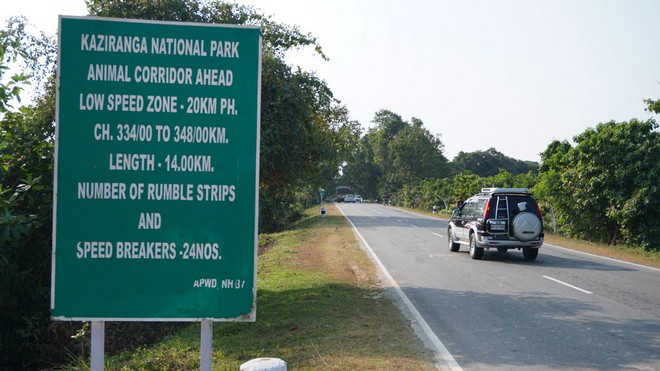
Environmentalists have cautioned that wildlife mobility is probably being disrupted by developmental activities being done in several designated wildlife corridors of Kaziranga National Park and Tiger Reserve. According to a letter sent by environment and RTI activist Rohit Choudhury to the secretary of the ministry of environment and forests, these include solar floodlights at various points along NH 37 that cut through the Kaziranga-Karbi Anglong landscape in Assam; concrete and metal posts along the roadsides for the purpose of affixing cable fencing; and fender-barriers put up along the roadsides. He said that in some locations, paver blocks have been used to pave the wider road margins.
“It is well known that the NH-37 highway that crosses Kaziranga National Park serves as a barrier to the unrestricted movement of wild animals within the park and between it and the neighboring forest areas. Geographically speaking, Karbi Anglong and Kaziranga form a same environment, and the migration of larger wildlife—particularly during floods—requires reliable connectivity.The nine animal corridors in Kaziranga National Park, which run from Rangalu to Borjuri and are the main routes for wildlife migration, have been designated and made public. The Hon’ble National Green Tribunal has prohibited certain types of activities in the corridors,” he continued in his letter, which Hindustan Times has examined.
The migration of wild animals across NH-37 has been entirely disrupted due to the construction of concrete and metal posts for the purpose of attaching cable fencing, the installation of fender-barriers, and the placement of paver blocks on road margins near Burapahar. The vegetation cover along the National Highway (NH), which provides cover for wildlife during high floods, has also been cleared while this work is being done. Furthermore, numerous locations along the NH have strong solar floodlights installed, which confuse and disorient wildlife, particularly nocturnal species like the Royal Bengal Tiger. In actuality, the installation of solar lights has exacerbated the effects of cars using high beam headlights, and it will undoubtedly negatively impact animal behavior.
The June 2 letter, which was also addressed to the Chief Secretary of the Government of Assam, the Director General of Forests, the Special Secretary of the MoEFCC, the Principal Chief Conservator of Forests, and the Head of the Forest Force, Assam, among others, highlighted that the installation of solar lights has actually exacerbated the effects of vehicle traffic operating with high-beam headlights and is certain to have negative effects on animal behavior.
“We have put in place mitigation measures. Since there aren’t hundreds of flood lights, there shouldn’t be much of an impact. The fences and metal posts have already been taken down. “We are addressing the concerns raised by Mr. Choudhury,” Kaziranga National Park Director Sonali Ghosh stated.
A 2020 research by the Wildlife Institute of India assessed the effects of NH715 (formerly NH37) on wildlife in the Kaziranga reserve and found that 1,176 animals perished in collisions between wildlife and vehicles between January and December of that year. The yearly monsoon floods from nearby Brahmaputra, which occur in Kaziranga National Park, were found to be the primary cause of large mammal deaths in collisions between wildlife and vehicles.
